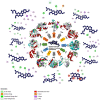Deciphering the Biomolecules from Bacillus atrophaeus NMB01 Untangles the Anti-Oomycetes Action of Trioxsalen and Corynan-17-ol, Against Phytophthora infestans Inciting Late Blight of Potato
- PMID: 36458213
- PMCID: PMC9705679
- DOI: 10.1007/s12088-022-01044-7
Deciphering the Biomolecules from Bacillus atrophaeus NMB01 Untangles the Anti-Oomycetes Action of Trioxsalen and Corynan-17-ol, Against Phytophthora infestans Inciting Late Blight of Potato
Abstract
The antagonistic Bacillus spp. is known well for the production of versatile antimicrobial biomolecules with broad spectrum of action against different types of plant pathogens. Considering the significance of metabolically active biomolecules, attempts were made to decipher the anti-oomycete nature of biomolecules produced by Bacillus atrophaeus NMB01 during di-trophic interaction with Phytophthora infestans. Ten biomolecules produced by B. atrophaeus NMB01 during di-trophic interaction with P. infestans were docked against the twelve target proteins of P. infestans. Molecular docking of biomolecules reported trioxsalen and corynan-17-ol,18,19-didehydro-10-methoxy-acetate(ester) as best hits with highest binding energy in the range of - 7.5 to - 5 kcal/mol against target proteins of P. infestans. Comparatively less binding energy was observed for commercially available fungicides mandipropamid and metalaxyl on docking against the target proteins of P. infestans. We also confirmed the direct impact of trioxsalen andcorynan-17-ol, on P. infestans under in vitro with 66% and 50% inhibition of mycelial growth of P. infestans, respectively. This is the first study attempted to untangle the role of bioactive anti-oomycete compounds produced by B. atrophaeus strain NMB01 during di-trophic interaction with P. infestans against late blight pathogen P. infestans infecting potato. From the present study, we conclude that the biomolecules, trioxsalen and corynan-17-ol, can be explored for the management of P. infestans, the incitant of late blight of potato.
Supplementary information: The online version contains supplementary material available at 10.1007/s12088-022-01044-7.
Keywords: Bacillus atrophaeus NMB01; Corynan-17-ol,18,19-didehydro-10-methoxy-, acetate (ester); Molecular docking; Phytophthora infestans; Trioxsalen.
© Association of Microbiologists of India 2022, Springer Nature or its licensor (e.g. a society or other partner) holds exclusive rights to this article under a publishing agreement with the author(s) or other rightsholder(s); author self-archiving of the accepted manuscript version of this article is solely governed by the terms of such publishing agreement and applicable law.
Conflict of interest statement
Conflict of interestThe authors declare that there is no conflict of interest.
Figures



Similar articles
-
Nonanol, an Induced Biomolecule Produced by Bacillus atrophaeus NMB01 During Interaction With Phytophthora infestans Can be Explored as a Novel Formulation for the Management of Late Blight of Potatoes.J Basic Microbiol. 2025 Apr 15:e70033. doi: 10.1002/jobm.70033. Online ahead of print. J Basic Microbiol. 2025. PMID: 40235205
-
Pan-genome analysis and molecular docking unveil the biocontrol potential of Bacillus velezensis VB7 against Phytophthora infestans.Microbiol Res. 2023 Mar;268:127277. doi: 10.1016/j.micres.2022.127277. Epub 2022 Dec 13. Microbiol Res. 2023. PMID: 36577205
-
Endophytic Bacillus subtilis H17-16 effectively inhibits Phytophthora infestans, the pathogen of potato late blight, and its potential application.Pest Manag Sci. 2023 Dec;79(12):5073-5086. doi: 10.1002/ps.7717. Epub 2023 Aug 23. Pest Manag Sci. 2023. PMID: 37572366
-
Harnessing Plant's Arsenal: Essential Oils as Promising Tools for Sustainable Management of Potato Late Blight Disease Caused by Phytophthora infestans-A Comprehensive Review.Molecules. 2023 Oct 27;28(21):7302. doi: 10.3390/molecules28217302. Molecules. 2023. PMID: 37959721 Free PMC article. Review.
-
Late blight resistance genes in potato breeding.Planta. 2022 May 16;255(6):127. doi: 10.1007/s00425-022-03910-6. Planta. 2022. PMID: 35576021 Free PMC article. Review.
References
-
- Caulier S, Gillis A, Colau G, Licciardi F, Liepin M, Desoignies N, Modrie P, Legreve A, Mahillon J, Bragard C. Versatile antagonistic activities of soil-borne Bacillus spp. and Pseudomonas spp. against Phytophthora infestans and other potato pathogens. Front Microbiol. 2018;9:143. doi: 10.3389/fmicb.2018.00143. - DOI - PMC - PubMed
LinkOut - more resources
Full Text Sources
Miscellaneous
